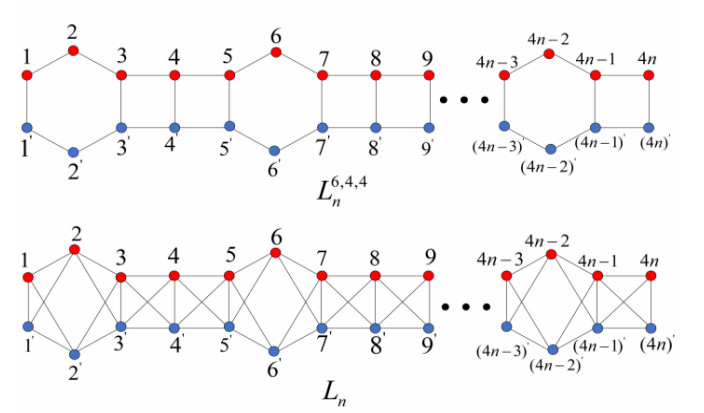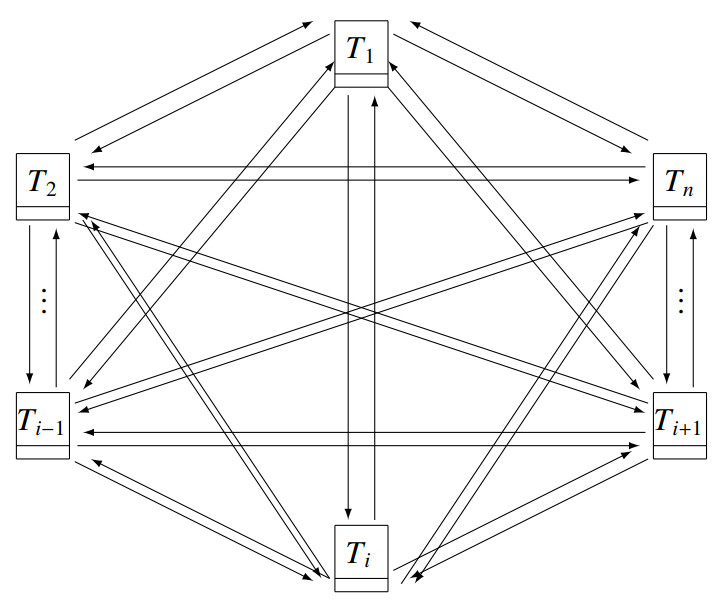1.
Introduction
Throughout this article, we only consider simple, undirected, and finite graphs and assume that all graphs are connected. Suppose G is a graph with the vertex set V(G)={v1,v2,⋅⋅⋅,vn} and the edge set E(G)={e1,e2,⋅⋅⋅,em}. The adjacency matrix A(G) is a 0−1n×n matrix indexed by the vertices of G and defined by aij=1 if and only if vsvt∈EG. For more notation, one refer to [1].
The Laplacian matrix of graph G is defined as L(G)=D(G)−A(G), and assume that the eigenvalues of L(G) are labeled 0≤μ1<μ2<⋅⋅⋅<μn.
The normalized Laplacian matrix is given by
The distance, dij=dG(vs,vt), between vertices us and ut of G is the length of the shortest us, ut-path in G. The Wiener index [2,3] is the sum of the distances of any two vertices in the graph G, that is
In 1947, the distance-based invariant first appeared in chemistry [2,3] and began to the applied to mathematics 30 years later [5]. Nowadays, the Wiener index is widely used in mathematics [6,7,8] and chemistry [9,10,11].
In a simple graph G, the degree, dij=dG(vi), of a vertex vi is the number of edges at vi. The Gutman index [12] of the simple graph G is expressed by
Klein and Randic initially outlined the concepts associated with the resistance distance of the graph. Assume that each edge is replaced by a unit resistor, and we use rst to denote the resistance distance between two vertices s and t. Similar to the Wiener index, the Kirchhoff index [13,14] of graph G is expressed as the sum of the resistance distances between each two vertices, that is
In 2007, Chen and Zhang [15] defined the multiplicative degree-Kirchhoff index [16,17], that is
Phenyl is a conjugated hydrocarbon, and L6,4,4n denote a linear chain, containing n hexagons and 2n−1 squares, as shown in Figure 1.
With the rapid changes of the times, organic chemistry has also developed rapidly, which has led to a growing interest in polycyclic aromatic compounds.
In 1985, the computational method and procedure of the matrix decomposition theorem were proposed by Yang [18]. This led to the solution of some problems in graph networks and allowed the unprecedented development of self-homogeneous linear hydrocarbon chains. For example, in 2021, X.L. Ma [20] got the normalized Laplacian spectrum of linear phenylene, and the linear phenylene containing it has n hexagons and n−1 squares. L. Lan [21] explored linear phenylene with n hexagons and n squares. Umar Ali [22] analyzed the strong prism of a graph G, which is the strong product of the complete graph of order 2, and X.Y. Geng [23] obtained the Laplacian spectrum of L6,4,4n, which contains n hexagons and 2n−1 squares. J.B. Liu [24] derived the Kirchhoff index and complexity of On, which denoting linear octagonal-quadrilateral networks. C. Liu [25] got the Laplacian spectrum and Kirchhoff index of Ln, and Ln has t hexagons and 3t+1 quadrangles.
Inspired by these recent works, we try to investigate the Laplacians and the normalized Laplaceians for graph transformations on phenyl dicyclobutadieno derivatives.
The various sections of this article are as follows: In Section 2, we proposed some concepts and lemmas and used them in subsequent articles. In Section 3 and Section 4, we acquired the Laplacian matrix and the normalized Laplacian matrix, then we made sure the Kirchoff index, the multiplicative degree-Kirchoff index, and the complexity of Ln. In Section 5, we obtained conclusions based on the calculations in this paper.
2.
Preliminary works
In this article, graph Ln and graph L6,4,4n are portrayed in Figure 1. Define the characteristic polynomial of matrix U of order n as PU(x)=det(xI−U).
It is easy to understand that π=(1,1′)(2,2′)⋯((4n),(4n)′) is an automorphism. Let V1={u1,u2,⋯,u4n+1,v1,⋯,v4n},V2={u′1,u′2,⋯,u′4n,v′1,⋯,v′4n+1}, |V(Ln)|=8n and |E(Ln)|=19n−4. Thus, the (normalized) Laplacians matrix can be expressed in the form of a block matrix, that is
where LVsVt and LVsVt are a submatrix consisting of rows corresponding to the vertices in Vs and columns corresponding to the vertices in Vt, s,t=0,1,2. Let
then
and Q′ is the transposition of Q.
LA=LV1V1+LV1V2, LS=LV1V1−LV1V2, LA=LV1V1+LV1V2, LS=LV1V1−LV1V2
Lemma 2.1. [20] If G is a graph and suppose that LA(G),LS(G),LA(G), and LS(G) are determined as above, then
Lemma 2.2. [26] With the extensive study of the Kirchhoff index, Gutman and Mohar proposed an algorithm based on the relation between the Kirchhoff index and the Laplacian eigenvalues, namely
and the eigenvalues of L(G) are 0=ξ1<ξ2≥⋯≥ξn(n≥2).
Lemma 2.3. [14] Suppose that the eigenvalues of L(G) are ξ1≤ξ2≤⋯≤ξn, then its multiplicative degree-Kirchhoff index can be denoted by
Lemma 2.4. [1] The number of spanning trees in G can also be called the complexity of G. If G is a graph with |VG|=n and |EG|=m. Let λi(i=2,3,⋯,n) be the eigenvalues of L(G). Then the complexity of G is
3.
Kirchhoff index of Ln
In this section, the main objective is to find out the Kirchhoff index of Ln. Then, combining the definition of the Laplacian matrix and Eq (1.1), we can write these block matrices as follows:
and
Hence,
and
Assume that 0≤α1<α2≤α3≤⋯≤α4n are the roots of PLA(x)=0, and 0≤β1≤β2≤β3≤⋯≤β4n are the roots of PLS(x)=0. By Lemma 2.2, we immediately have
Obviously, ∑4nj=11βj can be obtained according to LS.
Next, we focus on computing ∑4ni=11αi. Let
Based on Vieta's theorem of PLA(x), we can exactly get the following equation:
For the sake of convenience, let Ms be used to express the s−th order principal minors of matrix A, and ms=detMs is recorded. We can get m1=2,m2=4,m3=8.
And
by further induction, we have
In this way, we can get two theorems.
Theorem 3.1. (−1)4n−1a4n−1=(4n)24n−1.
Proof. Due to the sum of all the principal minors of order 4n−1 of LA is (−1)4n−1a4n−1,
where
Let m0=1,detU0=1, because of the symmetry of matrix LA, then detU4n−s=detM4n−s. Hence
as desired. □
Theorem 3.2. (−1)4n−2a4n−2=(4n−1)(4n)(4n+1)24n−13.
Proof. Since the (−1)4n−2a4n−2 is the tatal of all the principal minors of order 4n−2 of LA, we have
where
and
Therefore, we can have
The proof is over. □
From the results of Theorem 3.1 and Theorem 3.2, we can get
where the eigenvalues of LA are 0≤α1<α2≤α3≤⋯≤α4n.
Lemma 3.3. Suppose L6,4,4n be the dicyclobutadieno derivative of phenylenes and the graph Ln be obtained from the transformation of the graph L6,4,4n.
Proof. Substituting Eqs (3.5) and (3.6) into (3.4), the Kirchhoff index of Ln can be expressed
The result is as desired. □
The Kirchhoff index of Ln from L1 to L12 is shown in Table 1.
Next, we will further consider the Wiener index of Ln.
Lemma 3.4. Let L6,4,4n be the dicyclobutadieno derivative of [n]phenylenes, and the graph Ln be obtained from the transformation of the graph L6,4,4n, then
Proof. Consider dst for all vertices. For the sake of convenience, we divide the vertices of the graph into the following five categories:
Case 1. Vertex 1 of Ln:
Case 2. Vertex 4j−3(j=1,2,⋯,n) of Ln, i=4j−3:
Case 3. Vertex 4j−2(j=1,2,⋯,n) of Ln, i=4j−2:
Case 4. Vertex 4j−1(j=1,2,⋯,n) of Ln, i=4j−1:
Case 5. Vertex 4j(j=1,2,⋯,n) of Ln, i=4j:
Hence, we have
Consider the above results of the Kirchhoff index and the Wiener index. We can get following equation when n tends to infinity:
The result is as desired. □
4.
Multiplicative degree-Kirchhoff index and complexity of Ln
In this section, we use the eigenvalues of the normalized Laplacian matrix to determine the multiplicative degree-Kirchhoff index of Ln. Besides, we calculate the complexity of Ln. Then
and
Therefore,
and
Assume that the roots of PLA(x)=0 are 0≤ξ1<ξ2≤ξ3≤⋯≤α4n, and 0≤γ1≤γ2≤γ3≤⋯≤γ4n are the roots of PLS(x)=0. By Lemma 2.3, we can get
Since Ls is a diagonal matrix. Obviously, its diagonal elements 1,43 and 65 correspond to the eigenvalues of Ls, respectively. Then, it can be clearly obtained as
Let
1ξ2,1ξ3,⋅⋅⋅,1ξ4n+1are the roots of the following equation
Based on the Vieta' s theorem of PLA(x), we can get
Similarly, we can get another two interesting facts.
Theorem 4.1. (−1)4n−1b4n−1=259(38n−8)(4125)n.
Proof. Let sp=detFp, then we have s1=23,s2=13,s3=215,s4=475, and
After further simplification, the transformation form of the above formula is obtained.
Similarly, we have t1=23,t2=415,t3=215,t4=475, and
Therefore, the transformation form of the above formula is obtained.
Since the (−1)4n−1b4n−1 is the total of all the principal minors of order 4n−1 of LA, we have
The proof of Theorem 4.1 completed. □
Theorem 4.2. (−1)4n−2b4n−2=13240(14520n3+4599n2−1496n+3)(4125)n.
Proof. We observe that the sum of all the principal minors of order 4n in LA is (−1)4n−2b4n−2, then
By Eq (4.8), we know that the result of detLA[s,t] will change with the values of s and t. Then we can get the following twenty cases:
Case 1. i=4s, j=4t, 1≤s<t≤n,
Case 2. i=4s, j=4t+1, 1≤s≤t≤n−1,
Case 3. i=4s, j=4t+2, 1≤s≤t≤n−1,
Case 4. i=4s, j=4t+3, 1≤s≤t≤n−1,
Case 5. i≡0, j=4n, 1≤s≤t,
Case 6. i=4s+1, j=4t, 1≤s<t≤n,
Case 7. i=4s+1, j=4t+1, 1≤s<t≤n−1,
Case 8. i=4s+1, j=4t+2, 1≤s<t≤n−1,
Case 9. i=4s+1, j=4t+3, 0≤s≤t≤n−1,
Case 10. i≡1, j=4n+1, 0≤s≤n,
Case 11. i=4s+2, j=4t, 0≤s<t≤n,
Case 12. i=4s+2, j=4t+1, 0≤s<t≤n−1,
Case 13. i=4s+2, j=4t+2, 0≤s<t≤n−1,
Case 14. i=4s+2, j=4t+3, 0≤s≤t≤n−1,
Case 15. i≡2, j=4t+3, 0≤s≤n−1,
Case 16. i=4s+3, j=4t, 0≤s<t≤n,
Case 17. i=4s+3, j=4t+1, 0≤s<t≤n−1,
Case 18. i=4s+3, j=4t+2, 0≤s<t≤n−1,
Case 19. i=4s+3, j=4t+3, 0≤s<t≤n−1,
Case 20. i≡3, j=4t, 0≤s≤n−1,
Therefore, we can get
where
Hence
The proof of Theorem 4.2 completed. □
Let 0≤ξ1≤ξ2≤ξ3≤⋯≤ξ3n+2 are the eigenvalues of LA. We can get the following exact equation:
Theorem 4.3. Set L6,4,4n be the derivative [n]pheylenes, and the expression of the multiplicative degree-Kirchhoff index is
Proof. Together with Eq.(4.7) and Theorems 4.1 and 4.2, one can get
The result as desired. □
The multiplicative degree-Kirchhoff indices of Ln from L1 to L12, see Table 2.
Then we want to calculate the Gutman index of Ln.
Theorem 4.4. Suppose that L6,4,4n is the dicyclobutadieno derivative of [n]phenylenes and the graph Ln is obtained from the transformation of the graph L6,4,4n, then
Proof. Consider dij for all vertices. We divide the vertices of Ln into the following four categories.
Case 1. Vertex 4i−2(i=1,2,⋯,n) of Ln:
Case 2. Vertex 4i−1(i=1,2,⋯,n) of Ln:
Case 3. Vertex 4i(i=1,2,⋯,n) of Ln:
Case 4. Vertex 4i−3(i=1,2,⋯,n) of Ln:
According to Eq.(1.3), the Gutman index of Ln is
Therefore, combining with Kf∗(Ln) and Gut(Ln), we have
The result as desired.□
Finally, we want to know the complexity of Ln.
Theorem 4.5. For the graph Ln, we have
Proof. Based on Lemma 2.4, we can get
Note that
Hence,
The proof is over. □
Thus, we can get the complexity of Ln from W1 to W8 which are listed in Table 3.
5.
Conclusions
In this paper, the linear chain network with n hexagons and 2n−1 squares is considered. We have devoted ourselves to calculating the (multiplicative degree) Kirchhoff index, Wiener index, Gutman index, and complexity. In the meantime, we deduced that the ratio of the (multiplicative degree) Kirchhoff index to the (Gutman) Wiener index is nearly a quarter when n tends to infinity. These rules also apply to some other graphs.
Use of AI tools declaration
The authors declare they have not used Artificial Intelligence (AI) tools in the creation of this article.
Acknowledgments
This research was funded by the Anhui Provincial Natural Science Research Major Project (No. 2022AH040317) and the Anhui Provincial 2023 Action Project for Cultivating Young and Middle Aged Teachers in Universities (No. DTR2023095).
Conflict of interest
No potential conflicts of interest were reported by the authors.










 DownLoad:
DownLoad:




